Boxer, the ideal partner
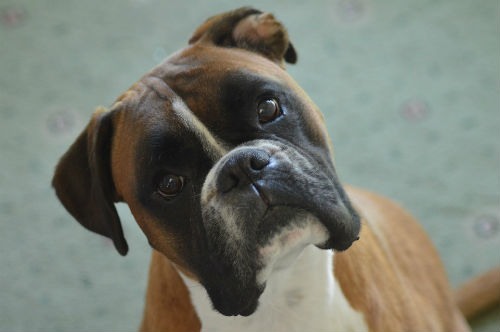 You must keep in mind that it is a race that has a lot of physical strength, therefore you have to constantly supervise them when they play with children. As are excellent company dogs, it is important to take them for a walk, play with them and keep them in frequent physical activity, so you will keep your pet very happy.
You must keep in mind that it is a race that has a lot of physical strength, therefore you have to constantly supervise them when they play with children. As are excellent company dogs, it is important to take them for a walk, play with them and keep them in frequent physical activity, so you will keep your pet very happy.
- Size: Medium.
- Weight: Between 25 and 32kg.
- Hair type: Very short and smooth.
- Character: Cheerful, playful, energetic, devout, intrepid, friendly, intelligent, loyal, confident, calm, brave
- Health: You can have some health problems.
- Life expectancy: Between 10 and 12 years.
Origin of the boxer
This breed is German origin, is born in Munich In the year 1.895, in a name farm "Von Dom". Its creators were Friedrich Robert, Lard König and R. Höpner, founders of the first "Deutscher Boxer Club". It is born from the crossing between a Bullenbeisser Brabant (extinct dog of German origin and race developed by the hunters. His name means bull bite or bull bites) and a bulldog (English bulldog, called as bull bites, by dogs used in bulls around the seventeenth century, being prohibited in the year 199, in the United Kingdom).
Boxer puppy care
By having a Boxer puppy, preferably from 8 weeks of birth, considers the attention you are going to provide. They are very playful and active. Do not leave it only for a long time and make it gently and tenderness. As it is a puppy, it can easily be scared. Despite his robust image, he is fragile, be very careful not to charge him followed, or bother while adapting to his new atmosphere. You should not scream, you have to talk to you with a calm tone of voice and you cannot hit you when you make some mischief, that would cause a trauma to the puppy and develop a fearful or aggressive attitude.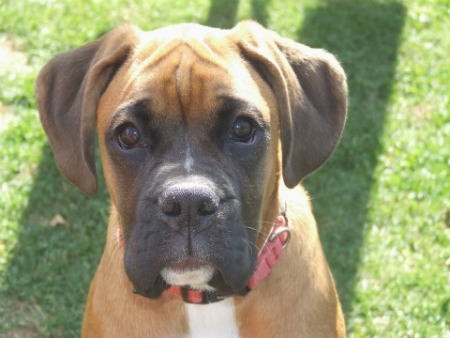 Allow you to meet every corner of your home, gain confidence and security. Show his bed and toys, who knows that he is also part of the family. It places the place where you will have your food and water, as are the place where your needs will do. Both of Puppies As adults, you can't neglect boxer's health, vaccines are important to prevent diseases. It fulfills its control of visits to the veterinarian. The ideal time to start vaccines control is from two or three months of age. The food must be special for race and according to age. It happens the same with personal care items that you use such as shampoo, brush or rubber glove to comb. Believe your boxer a routine, such as the time to go for a walk, play, feed, sleep and bath day.
Allow you to meet every corner of your home, gain confidence and security. Show his bed and toys, who knows that he is also part of the family. It places the place where you will have your food and water, as are the place where your needs will do. Both of Puppies As adults, you can't neglect boxer's health, vaccines are important to prevent diseases. It fulfills its control of visits to the veterinarian. The ideal time to start vaccines control is from two or three months of age. The food must be special for race and according to age. It happens the same with personal care items that you use such as shampoo, brush or rubber glove to comb. Believe your boxer a routine, such as the time to go for a walk, play, feed, sleep and bath day. 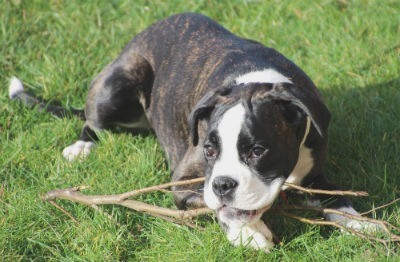 The puppies cannot be bathed before three months, or when they have been vaccinated, to be able to do it, you have to wait a week after their vaccination. You can clean your pet with wet wipes if necessary. It is recommended to bathe them every 25 or 30 days, so you do not eliminate the natural fat from your skin, which protects it from allergies and sensitivity. Physical and mental stimulation is necessary for the healthy development of your pet. Take it for a walk at least three times a day, run and play. Physical activity will help him develop his muscles and maintain a weight according to his height. Maintaining contact with nature and other environments will help you develop your senses remarkably.
The puppies cannot be bathed before three months, or when they have been vaccinated, to be able to do it, you have to wait a week after their vaccination. You can clean your pet with wet wipes if necessary. It is recommended to bathe them every 25 or 30 days, so you do not eliminate the natural fat from your skin, which protects it from allergies and sensitivity. Physical and mental stimulation is necessary for the healthy development of your pet. Take it for a walk at least three times a day, run and play. Physical activity will help him develop his muscles and maintain a weight according to his height. Maintaining contact with nature and other environments will help you develop your senses remarkably.
Boxer feed
Keep in mind the age of your boxer to fulfill your Power scheme. Before the fourth week of born it still depends on his mother and it is not advisable to give him solid foods. As it grows, it will be necessary to incorporate high feed in protein. The amount of food you must give will increase as it grows. In the same way, it decreases the frequency in which it must feed. Your diet must be careful and balanced, the most recommended that you consult with the veterinarian the food scheme that you should supply. Avoid giving your food remains, as well as foods rich in starch or chocolate. The ideal is to provide a I think of high quality like the one we offer in Blue Wolf.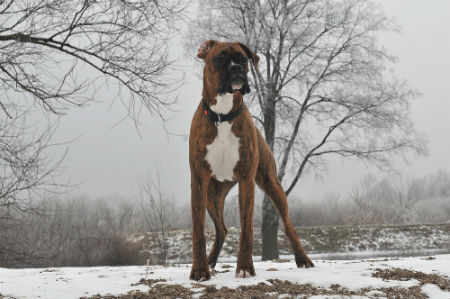 Verify that food likes your boxer and supervises if you tolerate it by observing the appearance of your feces. Do not forget that according to your diet, it will be a healthy and cheerful pet.
Verify that food likes your boxer and supervises if you tolerate it by observing the appearance of your feces. Do not forget that according to your diet, it will be a healthy and cheerful pet.
Race characteristics
- Boxer's life expectancy is 10 to 12 yearsThat depends on whether it is a healthy dog and the care you offer during your life time. You can have a short life average, if you don't give adequate attention. It is convenient to take it regularly to the veterinarian for control.
- It is one of the races of brachicéfalos dogs, that is, its skull is wide and short, and Chato snout compared to other dogs.
- He has a heavy and strong head, provided with his body and with a jaw of great pressure.
- On his face he presents a kind of black mask.
- His eyes are dark or almond.
- Of folded ears towards the cheeks.
- It is a dog with a strong neck and wide chest, so it demonstrates character and presence with its lively movement.
- Muscular, athletic, short back and strong legs.
- Its size can be from medium to large. The average height of the male is 57 to 63 cm, and the female is 53 to 59 cm.
- As for the weight of the male, it is between 27 and 32 kg, and the female of 25 to 29 kg.
- His fur is short, a bit hard and bright, in a stunned color but that comes to vary in some types of boxer, such as whites, black and brown.

We can find 5 types of boxer:
- Tabby: It is one of the most common, its fur is dark brown with black stripes on the back and white in the chest, belly, legs and ankles. Some are so dark that they seem black.
- White: Only 25% of the specimens of this breed are born white. They are not albinos but are sensitive to the sun. You must apply sunscreen if you are going to expose it to UV rays, since they are prone to cancer.
- Black: The color that generates controversy, because it is genetically unlikely that it is born of this color. There are only two reasons for your boxer to be black. The first is that it is not a pure race, for inheriting certain genes of their predecessors between the crossing of two mestizos but also boxer (which are not pure). The second is that it is tied but invested, that is, very dark.
- Tawny: It is from a single brown to almost reddish color, and also with white spots on the chest, belly and legs.
- Albino: How to know if it is albino or white? Take into consideration the color of their eyes, they are lightly color and their eyelids are pink for not producing melanin), unlike the white that has dark eyes.
 If you have any spout or snout, it is not albino. Both white and albino boxer can develop skin and eye cancer, so protection is recommended, mainly in summer. This type of boxer is difficult to find. As for your temperament, Boxer are dogs that stand out for their intelligence, energy and are very playful. It is usual that they are believed to be aggressive dogs, but nothing further from reality. They are usually family and protective animals of their surroundings. If any specimen is aggressive, it is because it has not been raised correctly.
If you have any spout or snout, it is not albino. Both white and albino boxer can develop skin and eye cancer, so protection is recommended, mainly in summer. This type of boxer is difficult to find. As for your temperament, Boxer are dogs that stand out for their intelligence, energy and are very playful. It is usual that they are believed to be aggressive dogs, but nothing further from reality. They are usually family and protective animals of their surroundings. If any specimen is aggressive, it is because it has not been raised correctly.
Boxer health
If you have offered your dog a balanced diet, you have kept it physically active and have given him all the love he deserves, you cannot rule out, or neglect, the possible diseases he may suffer in the future. The most common diseases in the boxer are usually presented by starting their old age, so you must be very attentive with some normal behavior. By knowing your health status, you can avoid or attend to any of the diseases that affect this race of dogs, such as:
The most common diseases in the boxer are usually presented by starting their old age, so you must be very attentive with some normal behavior. By knowing your health status, you can avoid or attend to any of the diseases that affect this race of dogs, such as:
- Heart problems
- Tumors
- Epilepsy
- Hip dysplasia, hereditary bone disease.
- Stomach torsion, presents inflammation and abdominal pain
- Spondylosis, degenerative condition of the spine
- Canine osteoarthritis, which causes a lot of pain and is presented in areas such as the hip and back
- Dermatitis
How to educate your pet
According to the smarter dog list of the psychologist and professor Stanley Coren, the boxer race is in the 48th position, for having a medium work intelligence and obedience. They respond 30% of the time. Between 40 and 80 repetitions need to understand an order.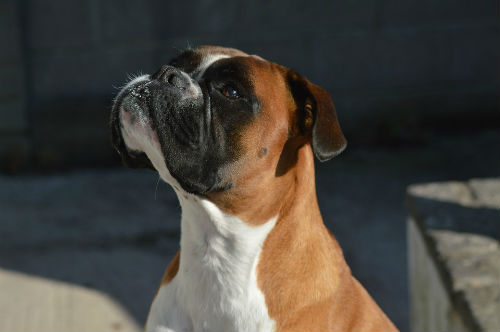 Canine intelligence has three aspects according to Coren:
Canine intelligence has three aspects according to Coren:
- Instinctive intelligence: It has skills such as grazing, guardian or company.
- Adaptive Intelligence: Ability to solve a problem.
- Labor and obedience intelligence: It is the ability to learn from the human being.
Some boxer curiosities
- The International Cinological Federation (FCI), International Federation responsible for promoting and governing cynology or canofilia, as well as dog breeding standards, Does not accept the white and albino boxer as copies of this breed.
- In Spain, boxer is not considered a dangerous race, although it is still thought that it is in other parts of the world.
- During the Second World War, the race was ignored, being accepted in the coming years in the United States.
Share
